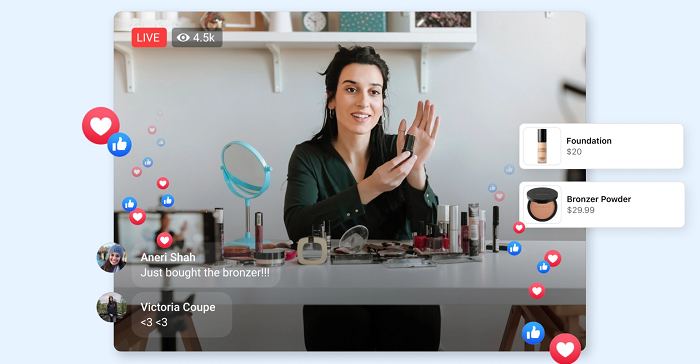SOCIAL
Facebook Shuts Down its Live Commerce Push, Which May Reflect Broader Disinterest in Live Shopping

In a move that likely reflects a bigger concern for TikTok than it does for Meta, and its overall growth plans, Facebook has announced that it’s shutting down its experiments with live shopping in the app, as of October 1st this year.
As reported by Business Insider, Facebook’s shuttering its native live stream shopping program, along with the ability to create product playlists, or tag products on Facebook, as it continues to refine its focus, and rationalize its development spend.
As explained by Facebook (via BI):
“As consumers’ viewing behaviors are shifting to short-form video, we are shifting our focus to Reels on Facebook and Instagram, Meta’s short-form video product. If you want to reach and engage people through video, try experimenting with Reels and Reels ads on Facebook and Instagram. You can also tag products in Reels on Instagram to enable deeper discovery and consideration.”
Live shopping will also remain active and in-development on Instagram, so it’s not abandoning the process entirely. But it doesn’t see a future for it on Facebook – which makes sense, but also reflects the lukewarm response to live shopping across western markets in general, which, as noted, could be a significant concern for TikTok and its growth plans.
Facebook’s been experimenting with live shopping implementations over the last few years, as part of a broader push to lean into rising eCommerce trends. At the peak of the pandemic, in which social distancing requirements forced physical stores to shut down, online shopping surged, accelerating already present trends towards in-app spending. But as restrictions have eased, eCommerce demand has also receded, likely more than many analysts had expected.
That’s forced a reassessment of business plans in line with consumer trends, which has seen platforms like Pinterest lose out – or at least, scale back to the mean, in terms of traditional eCommerce growth.
Which, as noted, could impact TikTok more so than other apps.
The key model for TikTok’s growth strategy is Douyin, the Chinese version of the app, which has over 600 million users in the region.
Douyin has been around for longer than TikTok, and is more advanced, which is why many of TikTok’s new tools and features look so polished – because they’ve already been implemented among Douyin’s massive user base.
Part of TikTok’s key challenge right now, however, lies in maximizing creator revenue, and giving its top stars more opportunities to make money in the app, because they can’t simply insert ads into their short-form clips like they would on YouTube.
The answer on Douyin has been in-app commerce, with the platform reportedly driving $118 billion in product sales, largely via live-stream commerce, in 2021 alone.
Live-stream commerce has become a key trend for the app, with sales generated via Douyin live broadcasts rising 7x year-over-year in 2021, and the number of eCommerce live broadcast users exceeding 384 million – more than half the platform’s user base.
Overall, live shopping is huge in China, with predictions that live shopping revenues will reach $400 billion in the region this year alone, equivalent to almost half of all eCommerce spending in the US last year. Live-stream commerce has also proven increasingly popular among younger audiences, with users aged 27 and under seeing the fastest adoption of live-stream spending.
That should spell big opportunities in other markets as well – but the fact that Facebook has decided to move away from the process suggests that it’s simply not catching on in the same way, and that western users are not adopting the live-stream shift with the same vigor as Chinese consumers.
That could be a cultural trend. It’s possible that Chinese users simply align more with these new platform uses, which is similarly reflected in the way that messaging apps have become essential connective tools throughout the region.
Western users have never adapted to messaging apps in the same way, and maybe that’s just a variation in approach, which can’t be overcome. Some have also suggested noted that there are simply fewer opportunities to buy products online in China, with sales restricted to certain apps.
That could make live shopping a more appealing prospect. But whatever the reason, the fact that western consumers are not jumping at the live shopping shift could be a big concern for TikTok’s growth potential – because if it’s not able to offer comparable compensation to what creators can make on YouTube or Instagram, you can bet that, eventually, those top stars will start migrating to greener pastures instead.
Creators have already expressed their frustration at the inconsistent and low payment amounts available via TikTok’s Creator Fund, while TikTok also recently scaled back its live shopping ambitions in Europe due to low adoption and internal conflicts.
If live shopping isn’t catching – which, again, Meta’s decision to scale back its push likely suggests – TikTok may have to find alternate means for creator revenue growth and opportunity. Which may not even exist – while TikTok’s parent company ByteDance is also under increasing financial pressure itself, and has been unwilling, at least thus far, to consider boosting creator payments.
TikTok is the app of the moment, and is on track to reach 1.5 billion users this year, which would make it the third biggest social platform by active usage. There’s no doubting its cultural relevance and presence. But eventually, its challenges in revenue share for top stars will become a bigger issue.
TikTok’s design also isn’t aligned to growing individual users’ audiences, as its algorithms sort through the best content from all users, in order to highlight the most relevant material and keep you scrolling. The fact that it opens to the ‘For You’ page, not ‘Following’, is also not aligned with helping creators maximize reach and audience – there are various flaws in its process that could reduce its appeal to those looking to make content creation their focus.
Will these concerns eventually weigh more heavily on the app? Facebook’s live shopping pull-out is certainly not a great sign in this respect.
SOCIAL
Snapchat Explores New Messaging Retention Feature: A Game-Changer or Risky Move?

In a recent announcement, Snapchat revealed a groundbreaking update that challenges its traditional design ethos. The platform is experimenting with an option that allows users to defy the 24-hour auto-delete rule, a feature synonymous with Snapchat’s ephemeral messaging model.
The proposed change aims to introduce a “Never delete” option in messaging retention settings, aligning Snapchat more closely with conventional messaging apps. While this move may blur Snapchat’s distinctive selling point, Snap appears convinced of its necessity.
According to Snap, the decision stems from user feedback and a commitment to innovation based on user needs. The company aims to provide greater flexibility and control over conversations, catering to the preferences of its community.
Currently undergoing trials in select markets, the new feature empowers users to adjust retention settings on a conversation-by-conversation basis. Flexibility remains paramount, with participants able to modify settings within chats and receive in-chat notifications to ensure transparency.
Snapchat underscores that the default auto-delete feature will persist, reinforcing its design philosophy centered on ephemerality. However, with the app gaining traction as a primary messaging platform, the option offers users a means to preserve longer chat histories.
The update marks a pivotal moment for Snapchat, renowned for its disappearing message premise, especially popular among younger demographics. Retaining this focus has been pivotal to Snapchat’s identity, but the shift suggests a broader strategy aimed at diversifying its user base.
This strategy may appeal particularly to older demographics, potentially extending Snapchat’s relevance as users age. By emulating features of conventional messaging platforms, Snapchat seeks to enhance its appeal and broaden its reach.
Yet, the introduction of message retention poses questions about Snapchat’s uniqueness. While addressing user demands, the risk of diluting Snapchat’s distinctiveness looms large.
As Snapchat ventures into uncharted territory, the outcome of this experiment remains uncertain. Will message retention propel Snapchat to new heights, or will it compromise the platform’s uniqueness?
Only time will tell.
SOCIAL
Catering to specific audience boosts your business, says accountant turned coach

While it is tempting to try to appeal to a broad audience, the founder of alcohol-free coaching service Just the Tonic, Sandra Parker, believes the best thing you can do for your business is focus on your niche. Here’s how she did just that.
When running a business, reaching out to as many clients as possible can be tempting. But it also risks making your marketing “too generic,” warns Sandra Parker, the founder of Just The Tonic Coaching.
“From the very start of my business, I knew exactly who I could help and who I couldn’t,” Parker told My Biggest Lessons.
Parker struggled with alcohol dependence as a young professional. Today, her business targets high-achieving individuals who face challenges similar to those she had early in her career.
“I understand their frustrations, I understand their fears, and I understand their coping mechanisms and the stories they’re telling themselves,” Parker said. “Because of that, I’m able to market very effectively, to speak in a language that they understand, and am able to reach them.”Â
“I believe that it’s really important that you know exactly who your customer or your client is, and you target them, and you resist the temptation to make your marketing too generic to try and reach everyone,” she explained.
“If you speak specifically to your target clients, you will reach them, and I believe that’s the way that you’re going to be more successful.
Watch the video for more of Sandra Parker’s biggest lessons.
SOCIAL
Instagram Tests Live-Stream Games to Enhance Engagement

Instagram’s testing out some new options to help spice up your live-streams in the app, with some live broadcasters now able to select a game that they can play with viewers in-stream.
As you can see in these example screens, posted by Ahmed Ghanem, some creators now have the option to play either “This or That”, a question and answer prompt that you can share with your viewers, or “Trivia”, to generate more engagement within your IG live-streams.
That could be a simple way to spark more conversation and interaction, which could then lead into further engagement opportunities from your live audience.
Meta’s been exploring more ways to make live-streaming a bigger consideration for IG creators, with a view to live-streams potentially catching on with more users.
That includes the gradual expansion of its “Stars” live-stream donation program, giving more creators in more regions a means to accept donations from live-stream viewers, while back in December, Instagram also added some new options to make it easier to go live using third-party tools via desktop PCs.
Live streaming has been a major shift in China, where shopping live-streams, in particular, have led to massive opportunities for streaming platforms. They haven’t caught on in the same way in Western regions, but as TikTok and YouTube look to push live-stream adoption, there is still a chance that they will become a much bigger element in future.
Which is why IG is also trying to stay in touch, and add more ways for its creators to engage via streams. Live-stream games is another element within this, which could make this a better community-building, and potentially sales-driving option.
We’ve asked Instagram for more information on this test, and we’ll update this post if/when we hear back.
-

 MARKETING6 days ago
MARKETING6 days agoRoundel Media Studio: What to Expect From Target’s New Self-Service Platform
-

 SEO6 days ago
SEO6 days agoGoogle Limits News Links In California Over Proposed ‘Link Tax’ Law
-
SEARCHENGINES6 days ago
Daily Search Forum Recap: April 12, 2024
-

 SEO5 days ago
SEO5 days ago10 Paid Search & PPC Planning Best Practices
-

 SEARCHENGINES5 days ago
SEARCHENGINES5 days agoGoogle Core Update Volatility, Helpful Content Update Gone, Dangerous Google Search Results & Google Ads Confusion
-

 SEO7 days ago
SEO7 days agoGoogle Unplugs “Notes on Search” Experiment
-

 MARKETING6 days ago
MARKETING6 days ago2 Ways to Take Back the Power in Your Business: Part 2
-

 PPC6 days ago
PPC6 days agoCritical Display Error in Brand Safety Metrics On Twitter/X Corrected















You must be logged in to post a comment Login